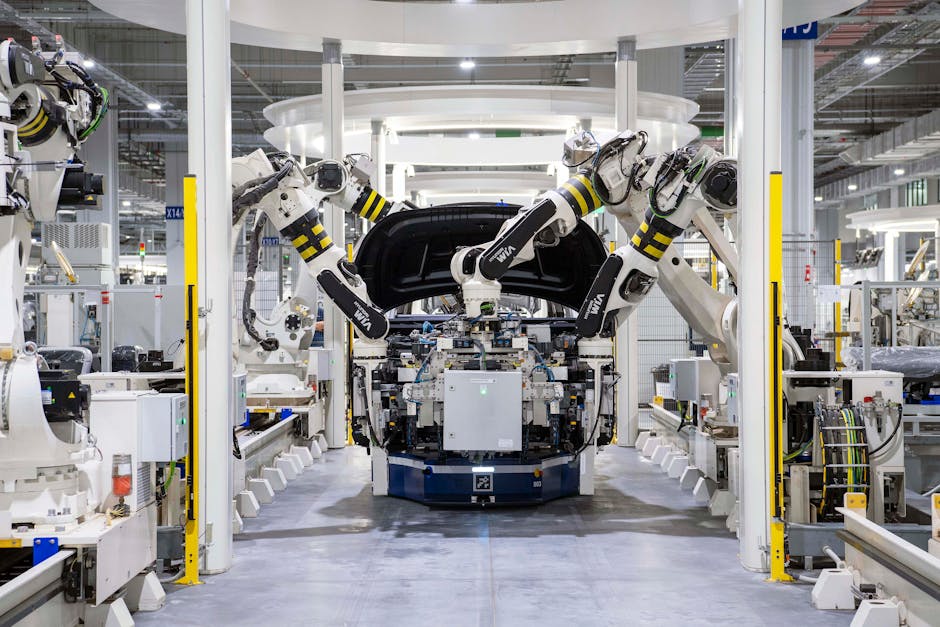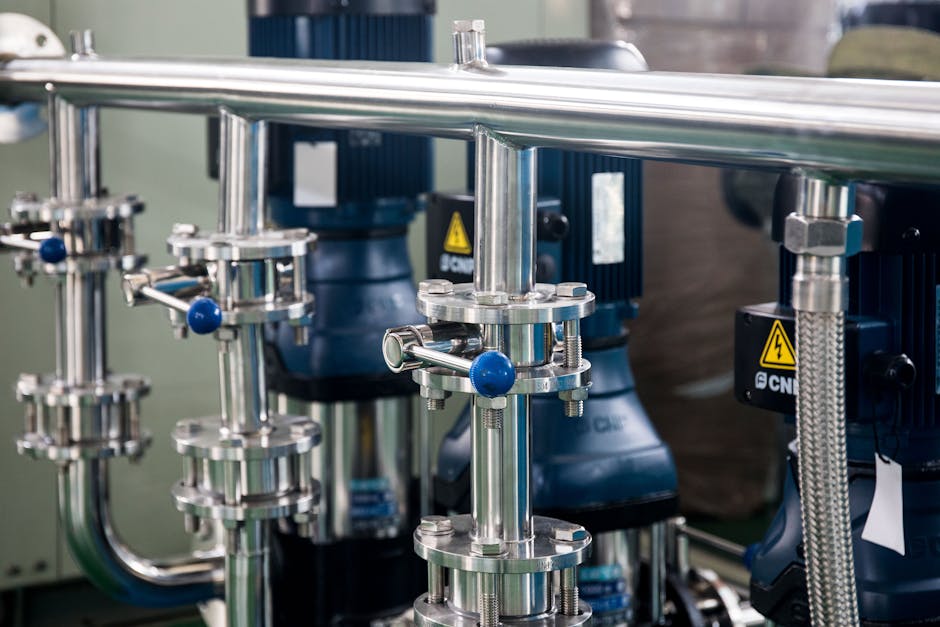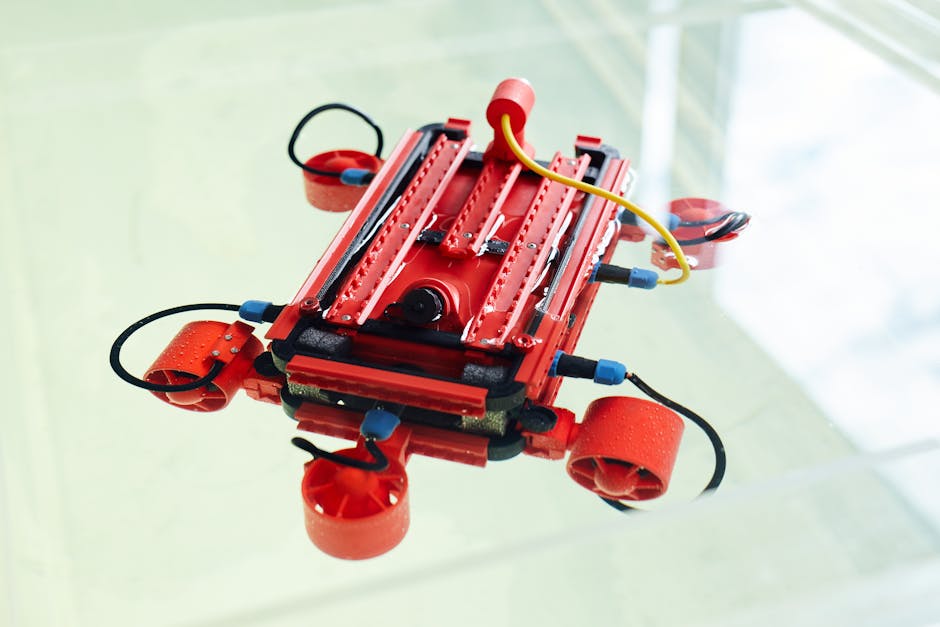Robotics and Automation: Transforming UK’s Manufacturing Landscape
As you explore the transformation of UK’s manufacturing landscape, you’re likely to discover the fusion of robotics, artificial intelligence, and IoT revolutionising production workflows, enhancing product quality, and boosting efficiency. Robotics and automation are reshaping the industry, enabling manufacturers to meet growing demands, improve quality control, and reduce labour costs. With government incentives and initiatives, the adoption of automation technologies is on the rise. As you dive deeper, you’ll uncover the benefits of automation, smart factories, and the future of workforce collaboration, revealing a transformed manufacturing landscape that’s more efficient, productive, and competitive than ever before.
Key Takeaways
• The UK’s industrial landscape is shifting towards automation, driven by the need for increased productivity and precision, with government incentives supporting this shift.• Robots are increasingly working alongside humans in manufacturing facilities, equipped with machine learning capabilities to learn from humans and adapt to new tasks.• Automation is substantially increasing production capacity, allowing manufacturers to meet growing demand, while also improving quality control and reducing labour costs.• Smart factories are emerging, converging advanced technologies like AI, robotics, and IoT to create highly connected, data-driven production environments.• Initiatives like the Industrial Strategy Challenge Fund and the Made Smarter programme are providing funding and support to help manufacturers invest in automation and digital technologies.
Robotics in Modern Manufacturing Era

As you step into a modern manufacturing facility, you’re likely to encounter robots working alongside humans, collaboratively assembling products with precision and speed.
This harmonious collaboration is a demonstration of the advancements in robotics, where robots have evolved from mere machines to trusted robot employees.
These robot employees are equipped with machine learning capabilities, enabling them to learn from their human counterparts and adapt to new tasks with ease.
As you observe the production line, you’ll notice robots efficiently performing tasks that require precision, such as assembly, welding, and inspection.
Their machine learning algorithms allow them to detect anomalies and make adjustments in real-time, ensuring consistent quality and reducing the risk of human error.
With the ability to work around the clock without fatigue, robots have substantially increased production capacity, allowing manufacturers to meet growing demand.
Moreover, robots are designed to augment human capabilities, freeing human workers to focus on higher-value tasks that require creativity, problem-solving, and critical thinking.
This human-robot collaboration hasn’t only improved productivity but also enhanced workplace safety, as robots take on hazardous tasks that would otherwise put humans at risk.
As the manufacturing landscape continues to evolve, it’s clear that robots are no longer just machines, but valued robot employees that are revolutionising the way we produce goods.
Automation Trends in UK Industry

The UK’s industrial landscape is witnessing a significant shift towards automation, with British manufacturers increasingly adopting robotics and artificial intelligence to streamline processes, enhance efficiency, and reduce costs.
As you navigate this transformative era, grasping the emerging trends shaping the industry is vital. One key trend is the growing demand for automation solutions, driven by the need for increased productivity, precision, and flexibility.
Government incentives are playing a vital role in encouraging the adoption of automation technologies. Initiatives like the Industrial Strategy Challenge Fund and the Made Smarter programme are providing funding and support to help manufacturers invest in automation and digital technologies.
This support is pivotal, as it enables businesses to overcome the initial investment hurdles and reap the long-term benefits of automation.
Another critical aspect of this trend is the need for Workforce retraining and upskilling. As automation takes over repetitive and mundane tasks, workers will require new skills to operate and maintain the advanced technologies.
You’ll see a growing emphasis on retraining programmes that focus on developing skills in areas like robotics, AI, and data analytics. This shift won’t only make certain that workers remain relevant in an automated workplace but also help to address the existing skills gap in the industry.
Boosting Efficiency With Automation

By integrating automation into your production lines, you can substantially reduce processing times, minimise waste, and optimise resource allocation, ultimately leading to increased productivity and efficiency.
This is because automation enables you to streamline processes, eliminate human error, and allocate resources more effectively. With automation, you can also leverage advanced technologies like machine learning to optimise production workflows and make data-driven decisions.
Reduced Labour Costs: Automating repetitive tasks reduces the need for manual labour, resulting in lower labour costs and increased productivity.
Improved Quality Control: Automated systems can detect and correct defects more accurately than human inspectors, leading to higher product quality.
Enhanced Process Optimisation: Automation enables real-time data analytics, which helps you identify areas for process improvement and optimise production workflows.
Workload Balance: Automation helps distribute workload more evenly, reducing the risk of overload and improving overall efficiency.
Minimised Downtime: Automated systems can detect and respond to equipment failures quickly, reducing downtime and increasing overall productivity.
The Rise of Smart Factories

You’re witnessing a seismic shift in manufacturing with the emergence of smart factories, where advanced technologies like artificial intelligence, robotics, and the Internet of Things (IoT) converge to create a highly connected, data-driven production environment. This transformation is revolutionising the way products are designed, produced, and delivered.
At the heart of smart factories lies the concept of Digital Twins, virtual replicas of physical systems that enable real-time monitoring, simulation, and optimisation of production processes. By leveraging IoT sensors and AI-driven analytics, manufacturers can gain unprecedented insights into their operations, predict maintenance needs, and optimise factory layouts for maximum efficiency.
| Smart Factory Component | Functionality | Benefits |
|---|---|---|
| Digital Twins | Virtual replication of physical systems | Real-time monitoring and optimisation |
| IoT Sensors | Collect and transmit production data | Enhanced process visibility and control |
| AI-driven Analytics | Analyse data for insights and predictions | Data-driven decision-making and optimisation |
In a smart factory, the traditional factory layout is reimagined, with production lines and machinery rearranged to maximise efficiency and minimise waste. This new layout is optimised using AI-driven simulations, ensuring that every step of the production process is streamlined and optimised. As you explore the world of smart factories, you’ll discover a sphere of possibilities where technology and innovation converge to transform the manufacturing landscape.
Improving Product Quality Control

In high-stakes production environments, maintaining rigorous quality control measures is crucial to preventing defects and guaranteeing customer satisfaction. As you implement robotics and automation in your manufacturing process, you’ll want to leverage cutting-edge technologies to guaranty the highest quality products.
To achieve this, you can utilise machine learning algorithms to analyse production data and identify patterns that may indicate potential defects. This enables you to take proactive measures to prevent defects, reducing the need for costly rework and improving overall efficiency.
Some key strategies for improving product quality control include:
- Implementing real-time monitoring systems to detect defects as they occur
- Utilising statistical process control methods to identify and correct deviations from ideal production conditions
- Integrating machine learning-powered defect detection systems to identify and isolate defective products
- Implementing automated inspection systems to reduce human error and increase inspection accuracy
- Utilising data analytics to identify trends and refine production processes
Robotics in Supply Chain Management

As you explore the role of robotics in supply chain management, you’ll discover how warehouse automation systems can optimise your operations.
By leveraging these systems, you can improve inventory management efficiency, reducing errors and increasing productivity.
Additionally, you’ll see how streamlined logistics processes can lead to faster order fulfilment and improved customer satisfaction.
Warehouse Automation Systems
Warehouse automation systems play a crucial role in streamlining supply chain operations by leveraging automation technologies, such as Machine Learning and Automated Guided Vehicles (AGVs), to enhance efficiency, reduce costs, and improve accuracy.
Warehouse automation systems provide several key benefits:
Increased productivity: Automation enables warehouses to process orders faster and more accurately, resulting in increased productivity and reduced labour costs.
Improved inventory management: Automated systems provide real-time inventory tracking, reducing stockouts and overstocking.
Enhanced order fulfilment: Automation facilitates timely and accurate order fulfilment, leading to higher customer satisfaction.
Reduced labour costs: Automated systems minimise labour costs by reducing the need for manual labour.
Scalability and flexibility: Warehouse automation systems can adapt to changing business needs, making them ideal for businesses of all sizes.
Inventory Management Efficiency
By leveraging robotics and automation, you can achieve inventory management efficiency, accurately tracking and managing inventory in real-time to minimise stockouts, overstocking, and associated costs.
This is made possible through the implementation of advanced Cycle Counting techniques, which enable you to maintain accurate inventory levels and detect discrepancies promptly.
With robotics and automation, you can optimise your inventory levels, reducing unnecessary stockholding and freeing up valuable warehouse space.
Inventory Optimisation is a key benefit of leveraging robotics and automation in inventory management.
By analysing demand patterns and sales data, you can adjust your inventory levels to meet changing market demands.
This guarantees that you’re holding the right stock levels, reducing waste, and minimising the risk of obsolescence.
Additionally, automated inventory management systems provide you with real-time data and insights, enabling you to make informed decisions about your inventory and optimise your supply chain operations.
Streamlined Logistics Process
You can substantially streamline your logistics process by integrating robotics and automation into your supply chain management, enabling you to boost productivity, reduce errors, and lower operational costs. By leveraging robotics and automation, you can transform your logistics process, making it more efficient, accurate, and cost-effective.
Enhanced Shipping: With automated sorting and packaging, you can accelerate your shipping process, ensuring timely delivery of products to customers.
Optimised Freight: Robotics can help optimise freight routes, reducing transportation costs and lowering carbon emissions.
Increased Accuracy: Automated systems minimise the risk of human error, ensuring accurate order fulfilment and reducing the need for costly rework.
Improved Warehouse Management: Robotics can help optimise warehouse layout, reducing storage costs and improving inventory management.
Real-time Visibility: With automated tracking and monitoring, you can have real-time visibility into your logistics process, enabling data-driven decision-making.
The Future of Workforce Collaboration

As collaborative robots and artificial intelligence continue to advance, they’ll increasingly augment human capabilities, transforming the workforce into a hybrid team of humans and machines.
You’ll find that this collaboration will revolutionise the way tasks are allocated, and responsibilities are assigned. With humans focussing on high-value tasks that require creativity, empathy, and problem-solving, machines will take over repetitive, mundane, and precision-oriented tasks.
In this new landscape, human-centred design will play a vital role in ensuring that the workforce is equipped to work effectively alongside machines.
This means that you’ll need to develop skills that complement those of machines, such as critical thinking, adaptability, and emotional intelligence. The skillset evolution will be critical, as humans will need to upskill and reskill to remain relevant in an increasingly automated environment.
As you navigate this new world of workforce collaboration, you’ll need to be adaptable, agile, and open to continuous learning.
The lines between tasks will blur, and you’ll find yourself working alongside machines that can learn, reason, and interact with you in ways that were previously unimaginable.
Cybersecurity in Automated Systems

With the increased reliance on automation and interconnected systems, securing sensitive data and preventing unauthorised access become critical concerns, especially since automated systems can be vulnerable to cyber threats. As you integrate more robots and automated systems into your manufacturing process, you also increase the risk of cyber attacks. These systems can provide a gateway for hackers to access sensitive data, disrupt operations, and even cause physical harm.
Network Vulnerabilities: Automated systems can be connected to the internet, making them vulnerable to network attacks.
System Breaches: Unauthorised access to automated systems can lead to data theft, disruption of operations, and even physical harm.
Lack of Encryption: Unencrypted data transmission can be intercepted by hackers, compromising sensitive information.
Insufficient Password Management: Weak passwords and inadequate password management can provide an open door for hackers.
Inadequate System Updates: Failure to update automated systems can leave them vulnerable to known security vulnerabilities.
To mitigate these risks, it’s essential to implement robust cybersecurity measures, such as encrypting data, implementing strong password policies, and regularly updating systems. By taking proactive steps to secure your automated systems, you can minimise the risk of cyber attacks and ensure the integrity of your operations.
Cost Savings and ROI Analysis

Implementing robotics and automation can substantially reduce operational costs and increase productivity, resulting in a tangible return on investment (ROI) for manufacturers who strategically integrate these technologies into their processes.
As you evaluate investing in robotics and automation, verify a positive financial outcome by assessing the cost savings and ROI. A thorough analysis of your current operational costs, including labour, energy, and maintenance expenses, will help you identify areas where automation can make a significant impact.
When calculating the ROI, you’ll need to examine the capital expenditure (CapEx) required to implement automation technologies. This includes the cost of equipment, instilment, and training.
However, the long-term benefits of increased productivity, reduced waste, and improved product quality can lead to significant cost savings.
To accurately assess the ROI, you’ll need to establish key financial metrics, such as payback period, net present value, and internal rate of return.
Embracing Industry 4.0 Technologies

Your company’s digital transformation accelerates when you integrate Industry 4.0 technologies, such as artificial intelligence, Internet of Things (IoT), and cloud computing, into your manufacturing processes.
This fusion enables you to harness the power of data-driven decision-making, predictive maintenance, and real-time monitoring.
By embracing Industry 4.0, you can create a Digital Twin of your production line, allowing for virtual testing and optimisation of new products and processes.
You can maintain Data Sovereignty by retaining control over your sensitive data and intellectual property.
Implement machine learning algorithms to analyse production data and identify areas for improvement.
Leverage IoT sensors to monitor equipment performance and schedule maintenance before breakdowns occur.
Scale your production capacity with cloud-based infrastructure, reducing the need for on-premiss hardware.
Conclusion
As you navigate the UK’s rapidly evolving manufacturing landscape, one statistic stands out: by 2025, robots will replace 30% of today’s jobs, freeing humans to focus on higher-value tasks.
Embracing automation and Industry 4.0 technologies is vital for businesses to stay competitive.
By adopting robotics and smart factories, you can boost efficiency, improve product quality, and reduce costs.
The future of manufacturing is here – are you ready to seise the opportunities it brings?
Contact us to discuss our services now!
